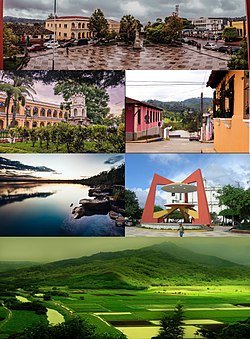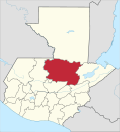Cobán
Cobán
Kob'an ( Kekchí) | |
|---|---|
 Above, from left to right: Central Park of Cobán, Governing Palace, City Streets, Lachuá Lagoon, Santo Domingo de Guzmán Cathedral and the biodiversity in Cobán. | |
| Coordinates: 15°29′0″N 90°22′0″W / 15.48333°N 90.36667°W | |
| Country | |
| Department | |
| Founded | August 4, 1543 |
| Government | |
| • Mayor | Koky Córdova (LDR) |
| Elevation | 1,320 m (4,330 ft) |
| Population (2018 census)[1] | |
| • Urban | 212,047 |
| Time zone | GMT -6 |
| Climate | Cfb |
Cobán (
As of the 2018 census, the population of the city of Cobán was 212,047 and that of the municipality was 212,421.[4] Cobán lies at an altitude of 1,320 metres or 4,330 feet above sea level and covers a total area of 1,974 km². It is located at the center of a major coffee-growing area.
Etymology
The name "Cobán" comes from
History
Order of Preachers in the Vera Paz
Between 1530 and 1531, captain
In the meantime, after a series of setbacks in
In November 1536, Las Casas settled in

In 1539 pope
Las Casas was appointed bishop of Chiapas in 1544, but he tried to apply the new ways in his diocese, they were flatly rejected by the
Las Casas and Angulo founded Rabinal, and the city of Cobán was the center of the new Catholic doctrine. A few years later, the natives started settling following the Spanish model and several towns were settled, like Tactic. The name "War zone" was change for "Vera Paz" (true peace), name that became official in 1547.[5] Cobán received the title of an imperial city by Charles V, Holy Roman Emperor and in 1599 Cobán became bishop's see. It was briefly known during this period as Ciudad Imperial (Spanish for "Imperial City") in Charles's honor.[3]
Independence and German settlers
As of 1850, Cobán population was estimated to be at 12000.
The city was developed by German coffee growers towards the end of the 19th century and was operated as a largely independent dominion until WWII.[16] In 1888 a German club was founded[17] and in 1935 a German school opened its doors in Cobán. Until 1930, about 2000 Germans populated the city.[17] In 1941, all Germans were expelled by the Guatemalan government, led at the time by Jorge Ubico because of pressure from the United States;[18] it has also been suggested Ubico's motivation was to seize control of the vast amounts of land Germans owned in the area.[18] Many ended up in internment camps in Texas and were later traded for American POW's held in Germany. A sizable resident German population persists though most having been completely assimilated into the Guatemalan culture through intermarriage. Multiple German architectonic elements can still be appreciated throughout Cobán.
The Germans also set up Ferrocarril Verapaz, a railway which connected Cobán with Lake Izabal, operated from 1895 until 1963 and was a symbol for the wealth in this coffee-growing region those days.[16]
Franja Transversal del Norte
The Northern Transverse Strip was officially created during the government of General Carlos Arana Osorio in 1970, by Legislative Decree 60-70, for agricultural development.
21st century: African oil palm

There is a large demand within Guatemala and some of its neighbors for edible oils and fats, which would explain how the African oil palm became so prevalent in the country in detriment of other oils, and which has allowed new companies associated to large capitals in a new investment phase that can be found particularly in some territories that form the Northern Transversal Strip of Guatemala.[22] The investors are trying to turn Guatemala into one of the main palm oil exporters, in spite of the decline on its international price. The most active region is found in Chisec and Cobán, in Alta Verapaz Department; Ixcán in Quiché Department, and Sayaxché, Petén Department, where Palmas del Ixcán, S.A. (PALIX) is located, both with its own plantation and those of subcontractors. Another active region is that of Fray Bartolomé de las Casas and Chahal in Alta Verapaz Department; El Estor and Livingston, Izabal Department; and San Luis, Petén, where Naturaceites operates.[22]
Climate
Cobán has a subtropical highland climate (Köppen: Cfb).
| Climate data for Cobán (1991–2020) | |||||||||||||
|---|---|---|---|---|---|---|---|---|---|---|---|---|---|
| Month | Jan | Feb | Mar | Apr | May | Jun | Jul | Aug | Sep | Oct | Nov | Dec | Year |
| Record high °C (°F) | 34.4 (93.9) |
34.7 (94.5) |
34.8 (94.6) |
36.0 (96.8) |
35.6 (96.1) |
35.0 (95.0) |
32.6 (90.7) |
32.0 (89.6) |
38.4 (101.1) |
34.8 (94.6) |
30.9 (87.6) |
30.8 (87.4) |
38.4 (101.1) |
| Mean daily maximum °C (°F) | 22.3 (72.1) |
23.9 (75.0) |
25.7 (78.3) |
27.8 (82.0) |
27.8 (82.0) |
27.5 (81.5) |
26.5 (79.7) |
26.9 (80.4) |
27.0 (80.6) |
24.9 (76.8) |
22.7 (72.9) |
22.4 (72.3) |
25.4 (77.7) |
| Daily mean °C (°F) | 16.9 (62.4) |
17.8 (64.0) |
19.0 (66.2) |
20.8 (69.4) |
21.2 (70.2) |
21.0 (69.8) |
20.5 (68.9) |
20.4 (68.7) |
20.5 (68.9) |
19.7 (67.5) |
17.9 (64.2) |
17.3 (63.1) |
19.4 (66.9) |
| Mean daily minimum °C (°F) | 10.8 (51.4) |
11.0 (51.8) |
11.3 (52.3) |
12.6 (54.7) |
13.8 (56.8) |
14.6 (58.3) |
14.1 (57.4) |
14.0 (57.2) |
14.4 (57.9) |
13.8 (56.8) |
12.5 (54.5) |
11.5 (52.7) |
12.9 (55.2) |
| Record low °C (°F) | 2.6 (36.7) |
3.8 (38.8) |
4.4 (39.9) |
3.1 (37.6) |
4.9 (40.8) |
6.8 (44.2) |
8.0 (46.4) |
8.6 (47.5) |
6.3 (43.3) |
6.4 (43.5) |
2.2 (36.0) |
3.0 (37.4) |
2.2 (36.0) |
| Average precipitation mm (inches) | 115.4 (4.54) |
88.3 (3.48) |
105.3 (4.15) |
109.6 (4.31) |
185.4 (7.30) |
265.0 (10.43) |
219.1 (8.63) |
238.7 (9.40) |
289.1 (11.38) |
300.3 (11.82) |
232.6 (9.16) |
116.8 (4.60) |
2,265.6 (89.20) |
| Average precipitation days (≥ 1.0 mm) | 12.6 | 9.1 | 8.6 | 8.1 | 14.4 | 19.8 | 20.3 | 19.6 | 21.5 | 19.9 | 15.7 | 12.8 | 182.4 |
| Source: NOAA[23] | |||||||||||||
Culture
Each year at the end of July, a festival of Guatemala's native peoples is held here, La Fiesta Nacional Indígena de Guatemala (Festival Folklórico). The festivities include a
Sports
Tourism

Cobán is surrounded by mountains laden with
Additional popular tourist spots in the city of Cobán include the El Calvario Church, the Dieseldorff coffee plantation, Plaza Magdalena Shopping Center and Coban's central plaza.
Geographic location
States[25]
See also
 Guatemala portal
Guatemala portal Geography portal
Geography portal- Alta Verapaz
- Franja Transversal del Norte
Notes
- ^ Ciudad Real diocesis included Chiapas, Soconusco, la Vera Paz (including the Lacandon jungle), Tabasco and the still non-conquered Yucatán Peninsula.
- ^ Las Casas accused Marroquín of having slave Indians and to have a repartimiento along with preaching "toxic doctrine"; Marroquín on the other hand, accused Las Casas of going beyond his jurisdiction.
References
Citations
- ^ Citypopulation.de Population of major cities in Guatemala
- ^ EB (1878).
- ^ a b EB (1911).
- ^ Citypopulation.de Population of departments and municipalities in Guatemala
- ^ ISBN 968-36-6150-5.
- ^ Anabitarte 1991, p. 105.
- ^ Anabitarte 1991, p. 107.
- ^ Anabitarte 1991, p. 109.
- ISBN 968-36-2016-7.
- ^ García Icazbalceta 1998, p. 149-151.
- ^ Baily, John (1850). Central America; Describing Each of the States of Guatemala, Honduras, Salvador, Nicaragua, and Costa Rica. London: Trelawney Saunders. p. 87.
- ^ Maudslay & Maudslay 1899, p. 105.
- ^ Martínez Peláez 1988.
- ^ Maudslay & Maudslay 1899, p. 99.
- ^ Maudslay & Maudslay 1899, p. 151-160.
- ^ a b "Deutschland en la Verapaz". Revista D. Guatemala: Prensa Libre. 5 July 2005. Archived from the original on 26 June 2015.
- ^ a b "Der Auslandsdeutsche kann nichts anderes sein als Nationalsozialist!". Risse im Context XXI; Magazin zur Alpenbergradigung (in German). Germany. 2002. Archived from the original on 10 February 2007.
- ^ S2CID 153433143.
- ^ "Franja Transversal del Norte". Wikiguate. Guatemala. Archived from the original on 2014-07-04. Retrieved 30 October 2014.
- ^ Solano 2012, p. 15.
- ^ Solano 2015, p. 6.
- ^ a b Solano 2015, p. 1
- ^ "World Meteorological Organization Climate Normals for 1991-2020 — Cobán". National Oceanic and Atmospheric Administration. Retrieved February 1, 2024.
- ^ a b SEGEPLAN. "Municipios de Alta Verapaz, Guatemala". Secretaría General de Planificación y Programación de la Presidencia de la República (in Spanish). Guatemala. Archived from the original on 30 June 2015. Retrieved 30 June 2015.
- ^ List of sister cities in Guatemala from Sister Cities International Archived 2008-08-29 at the Wayback Machine
Bibliography
- Anabitarte, Héctor (1991). Grandes Personajes. Bartolomé de las Casas (in Spanish) (Colaborativa del 75 Aniversario ed.). Labor. ISBN 84-335-7100-1.
- Baynes, T. S., ed. (1878). . Encyclopædia Britannica. Vol. 6 (9th ed.). New York: Charles Scribner's Sons. p. 83.
- Bucheli, Marcelo (2006). "The United Fruit Company in Latin America: Business Strategies in a Changing Environment". In Jones, Geoffrey; Wadhwani, R. Daniel (eds.). Entrepreneurship and Global Capitalism. Vol. 2. Cheltenham, Inglaterra: Edward Elgar. pp. 342–383. Archived from the original on 2007-10-13. Retrieved 2015-01-15.
- Chisholm, Hugh, ed. (1911). . Encyclopædia Britannica. Vol. 6 (11th ed.). Cambridge University Press. pp. 605–606.
- Corte internacional de La Haya (1955). "Nottebohm case (second phase). Judgement of April 6th, 1955" (PDF). I.C.J. Reports (in English and French): 4. Archived from the original (PDF) on 2012-02-10. Retrieved 2015-01-15.
- ISBN 970-07-1217-6.
- Martínez Peláez, Severo (1988). Racismo y análisis histórico de la definición del indio guatemalteco (in Spanish). Guatemala: Universitaria.
- Maudslay, Alfred Percival; Maudslay, Anne Cary (1899). A glimpse at Guatemala, and some notes on the ancient monuments of Central America(PDF). London (UK): John Murray.
- Solano, Luis (February 2012). Contextualización histórica de la Franja Transversal del Norte (FTN) (PDF) (in Spanish). Centro de Estudios y Documentación de la Frontera Occidental de Guatemala, CEDFOG. Archived from the original (PDF) on 13 November 2014. Retrieved 31 October 2014.
- Solano, Luis (15 July 2015). "Palma Africana" (PDF). Revista Enfoque (in Spanish) (36). Guatemala. Archived from the original (PDF) on 20 July 2015. Retrieved 19 July 2015.
External links
 Media related to Cobán at Wikimedia Commons
Media related to Cobán at Wikimedia Commons







